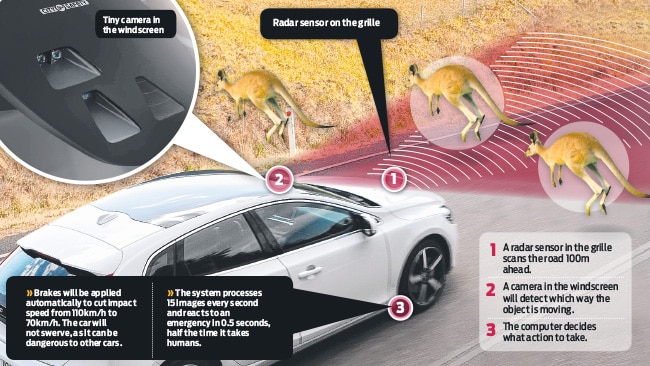Volvo auto-brake radar system detects kangaroos, cyclists
VOLVO is developing a radar system to avoid kangaroo collisions by automatically slamming on the brakes when it detects Skippy in the road.

SWEDISH car maker Volvo is developing technology that can avoid kangaroo collisions.
There are about 20,000 kangaroo strikes on Australia's roads each year according to insurance industry data.
But Volvo is working on a system that uses radar and camera technology to detect rogue roos -and automatically slam on the brakes if the driver does not.
It's an advancement of technology originally developed to detect pedestrians; later this year the same setup will enable selected Volvo cars to also detect cyclists.
"It will be a challenge to detect kangaroos because they are not as predictable as livestock and other large animals," said Martin Magnusson, a leading Volvo safety engineer.
"But we think we can come up with a way to detect them."
Volvo is in the early stages of development but "animal-detection" technology should be on the road within three years.
"We are starting with the large animals first, the ones that pose the greatest risk to drivers, such as a moose, a horse, or a cow, then we are working on ways to detect other animals, including kangaroos," Magnusson said.
Unfortunately man's best friend - dogs and cats - are not on the list.
"Driver safety is not an issue when it comes to a collision with those animals. Of course it's a pity, and I happen to like cats, but there are no plans to (detect dogs or cats)," Magnusson said.
Volvo says it will do most of the development work on kangaroos by using computer simulations.
It will then create a kangaroo crash test dummy similar to the one used by Holden for decades.
In the final stages of development Volvo says it will test its hi-tech system on kangaroos in Australia. "Eventually, we will have to test it in an environment with real kangaroos," Magnusson said.
The system will not swerve the car to avoid a kangaroo but will instead apply the brakes at full force to reduce the impact speed from, say, 110km/h to 70km/h.
A radar sensor in the grille scans the road 100 metres ahead and a camera in the windscreen works with the radar to detect which way the object is moving to help the computer decide what action to take, if any.
The system processes 15 images every second and can react to an emergency in half the time a human driver can, Volvo claims.
Magnusson says it takes 1.2 seconds for an attentive driver to detect danger and then apply the brakes, compared to about 0.5 second for the computer system.
"This truly is state of the art technology, because the brakes can be primed in milliseconds, much faster than a human," Magnusson said. "And we are only at the beginning of what is possible."
Volvo says it is not designed to take responsibility away from drivers. "It is a back-up in case they are distracted," Magnusson said.
The Volvo system will join a long line of gadgets designed to avoid crashes with kangaroos. Australian inventions mounted to the front of cars include plastic "whistles" and electronic sound transmitters that apparently only kangaroos can hear.
However, a 2006 study by the CSIRO found electronic sound emitters were not effective at deterring kangaroos. It tested one such device by switching it on in a paddock full of kangaroos and they didn't budge.


